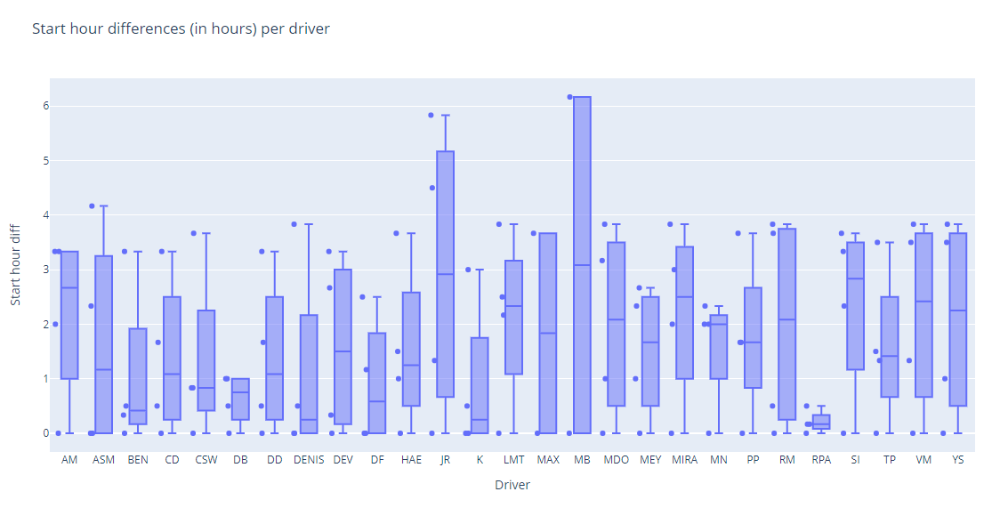Supply chains are a challenging topic and not only since Corona
With "adopre" adesso launches a solution for the logistics market: Within hours weekly schedules for hundreds of trips can be created.
 Algorithmic work-life balance: start time differences among drivers can be easily visualized and scheduling quickly adjusted
Algorithmic work-life balance: start time differences among drivers can be easily visualized and scheduling quickly adjusted
For a forwarding company, the optimal allocation of drivers and vehicles to routes is the highest goal. The sub-sector of live animal transports is particularly demanding. In addition to variables such as presence and driving time or the driver's vehicle qualifications, animal welfare requirements must also be taken into account. This quickly adds up to 20 optimization criteria, all of which must be met. The schedule based on these criteria is still created manually at many locations, and dispatchers with a lot of experience spend hours or days tinkering with the weekly schedules. For management, the current situation is then often difficult to comprehend.
Therefore, a Swiss logistics provider launched the project "adopre" (adesso operations research) together with adesso: A SaaS solution was developed within five months to coordinate about 200 weekly trips with 20-30 drivers and vehicles each. "Optimization takes place within a fixed framework of laws and operational necessities. So the space for order fulfillment has to be used intelligently", says Thomas Zimmermann, Solution Manager at adesso Schweiz AG. Basically, it looks like this: Live animals have to be picked up from the producers, the farmers, and brought to the slaughterhouse. The slaughterhouses have production lines that have to run constantly. Arrival must therefore be precisely timed and adapted to the shifts there, which therefore also applies to collection. Due to animal welfare requirements, routes and travel times are also precisely specified. According to Zimmermann, for example, "a driver must take the direct route from the producer to production without stopping in between."
Algorithmic Work-Life-Balance
But that's just the beginning: because the driving and presence times of the chauffeurs are also regulated by law. Furthermore, drivers should always have similar starting times in order to maintain a healthy sleep rhythm. "This is important for road safety reasons alone," explains Zimmermann. In addition, there is the issue of work-life balance, because truck drivers are also interested in a daily routine that is as regular as possible. Especially in the battle for scarce skilled workers, the drivers' well-being is of utmost importance to the companies. According to a report by SRF, around 5,000 drivers leave the industry in Switzerland every year, and only 2,000 new drivers join through training and lateral entry; the rest have to be brought in from abroad, where there is also a shortage. In other words: the drivers' sensitivities have real weight.
All in all, adesso had to consider 20 so-called "constraints". The solution space thus became very large very quickly, and in order for a good solution to emerge in a short time, scalability was important, as Zimmermann explains. "There is more going on around Easter, Pentecost or Christmas. So our solution had to create plans for all situations in the year in advance so that it could be tested for reliability before it went live."
Now, a new Docker container is simply launched per weekly schedule variant. Because of the cloud capability via AWS, as many plans as needed can be generated simultaneously in parallel. "This allows us to test the solution in all situations".
Forecasting Feature
adopre" has also made a limited amount of forecasting and controlling possible. "Our customer can now simulate how many vehicles are needed for a certain growth or how many drivers," says Zimmermann. This is also important because vehicle procurement can sometimes take up to a year. So the company can now run through different scenarios and plan better.
But these simulations can also be run in terms of constraints, because there is more than one optimal plan. The company thus has the opportunity to set priorities: What does the plan look like with the optimal work-life balance? And what does it look like if we want to focus primarily on the vehicles that are cheapest to maintain, or if it's all about margin? Finding the perfect balance is not easy, and aspirational attitudes can change.
Finally, "adopre" also allows for quick adjustments: If employees are absent at short notice, a new plan can be generated, currently within about 4 hours. Until now, the dispatcher needed up to 1.5 days for a new plan - not to mention the risk of a dispatcher's absence.
adesso now wants to position the solution on the market and win further logistics customers. The ongoing pandemic is likely to boost the demand for solutions that promise the necessary flexibility.
Techtalk:
For us, cloud-first applies: With Serverless, we rely on a cloud-native development model and Docker for containerization - in this case in the Amazon tech stack and thus Aurora as the database. For optimization, the right algorithms need to be chosen. Initially, we relied on genetic algos, but then decided on constraint programming with linear optimization, since the constraints reflect the knowledge of the dispatcher.
Relevante Links
Relevant links
>Table of contents show detail hide detail
- Index: >Details
- Editorial: What do developers think? >Details
- Basic Information >Details
- Insights, findings & excerpts >Details
- Developer Profile >Details
- How we do tech - Ergon >Details
- Programming, scripting and markup languages >Details
- How we do tech - adesso >Details
- Frameworks, libraries and tools >Details
- Covid-19 Impact in IT >Details
- Databases >Details
- Platforms >Details
- Preferences and tools >Details
- Carreer Aims + Opportunities >Details
- Ethics & Technology Trends >Details